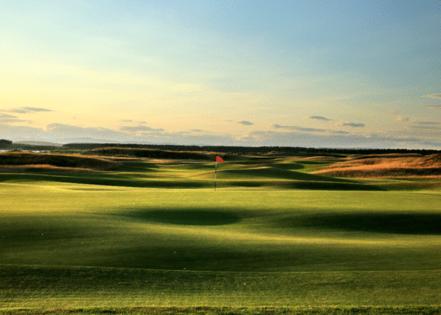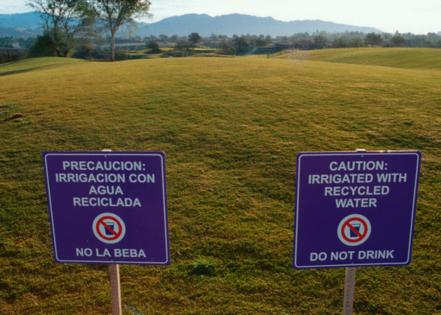Par for the course: How climate change is impacting golf courses
Published in Slideshow World
Subscribe
Par for the course: How climate change is impacting golf courses
From well-maintained fairways to pristine greens and tee boxes, golf may require more maintenance to uphold aesthetic beauty than any other sport.
Beyond typical upkeep, however, golf courses worldwide have faced myriad challenges brought by changes in weather patterns, including wildfires in the Western United States, coastal erosion in the United Kingdom, and hurricanes in the Southeastern U.S.
Climate change is making these natural phenomena worse, and golf's heavy resource needs make heat and drought stress, lack of access to water, erosion and flooding, damage from storms, and pest and disease pressures particularly problematic.
Amid calls from some of the game's top professionals to make the sport more sustainable, PrimePutt looked at how climate change is impacting golf courses and what the sport can do moving forward to adapt to this new landscape.
Visit thestacker.com for similar lists and stories.
A global issue
While it is well-documented that coastal areas are among the most impacted by climate change, golf courses are feeling the effects regardless of their location.
In Australia, courses store water for later use and for fighting wildfires.
At the "Home of Golf" in Scotland, a coalition of Scottish scientists reported in 2017 that up to one-fifth of the country's coast could be threatened by 2050 because of climate change, and 34 coastal courses are experiencing problems associated with rising sea levels, the BBC reported in April.
In the United States, September's Hurricane Helene flooded and damaged courses, including the famed Augusta National in Georgia.
Hurricane Milton made a similar impact weeks later, and golf clubs in the Southeast were left with costly cleanup bills to replace turf and landscaping on top of lost revenue from not being open, Golf Course Superintendents Association of America chief operating officer Kevin Sunderman said.
"I think it would be extremely difficult for a lot of our members in golf facilities to not notice some of the changes they're experiencing, especially those along the coastline," Sunderman told Stacker.
In areas such as Salt Lake County, Utah, where golf courses require millions of gallons of water every day to stay green, Sunderman said removing turfgrass can help reduce water usage.
"There have even been rebate programs offered by some of the water districts to golf courses to remove turfgrass, simply so there's less to irrigate," Sunderman said. "So, that seems like a no-brainer: Don't have grass where you don't necessarily need to have grass."
Beyond reducing the footprint of turfgrass, the future of golf course maintenance could include several technological and product advancements so courses can be cared for more efficiently.
That could be autonomous mowers, in-ground water sensors, and wetting agents that increase water absorption, Audubon International director of Signature Sanctuary Certification and longtime golf course superintendent Mark O'Mell said.
"Superintendents are stewards of their environment," O'Mell told Stacker.
Chipping in
Across the sport, efforts have been made to understand golf's impact on the environment, including the creation of Golf Course 2030—an initiative by the Royal and Ancient Golf Club of St. Andrews and other organizations to find solutions to mitigate climate change.
The plan notes golf courses can significantly reduce carbon emissions by transitioning to electric lawn maintenance equipment, sourcing low-carbon electricity, and reducing the volume of topdressing and areas to be topdressed. Golf courses can maximize carbon sequestration by only aerating tees and greens instead of fairways, which make up around 30% of a course.
Sunderman said GCSAA members follow established best practices for sustainability, such as planning, design, and construction of courses, land and water use, and pest control regulations.
An example of responsible pest control, Sunderman said, is keeping course management records that lead to the targeted use of pesticides.
"Rather than blanket the entire golf course with any kind of pesticide application, I'm only going to treat those areas that actually need to be treated," Sunderman said. "Within that, you set a threshold. So, just because you see a single bug doesn't mean you go out and spray 150 acres of turf."
The Trust for Public Land has transformed former golf courses in California into natural landscapes. In Michigan, two of the more than 50 golf courses that have closed since 2000 have found second lives as nature preserves.
A par-3 golf course in Park City, Utah, was recognized in 2023 for meeting strict water conservation measures by maintaining just 1 acre of turf per hole and using an existing freshwater recreation lake that doesn't require electricity for pumping since it employs a gravity-based system.
With the standard golf course covering about 150 acres, Sunderman said one of the most effective ways to implement sustainability is to consider how much of the course needs to be in pristine condition, noting that just 2% of those acres are usually composed of greens.
"After that, the level of maintenance and inputs and products really falls off pretty significantly, because golfers don't have the same expectations for the rough typically that they do for those three acres of greens," he said.
Story editing by Mike Taylor. Additional editing by Kelly Glass. Copy editing by Kristen Wegrzyn.
This story originally appeared on PrimePutt and was produced and distributed in partnership with Stacker Studio.









Comments